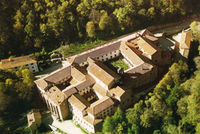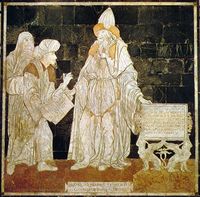Difference between revisions of "Category:Enochic Studies--1450s"
| Line 29: | Line 29: | ||
==Related categories== | ==Related categories== | ||
*[[:Category:Second Temple Studies--1400s|Second Temple Studies in the 1400s]] | *[[:Category:Second Temple Studies--1400s|Second Temple Studies in the 1400s]] | ||
*[[:Category:Historical Jesus Studies--1400s|Historical Jesus in the 1400s]] | *[[:Category:Historical Jesus Studies--1400s|Historical Jesus Studies in the 1400s]] -- [[:Category:Pauline Studies--1400s|Pauline Studies in the 1400s]] | ||
*[[:Category:Josephus Studies--1400s|Josephus Studies in the 1400s]] | *[[:Category:Josephus Studies--1400s|Josephus Studies in the 1400s]] -- [[:Category:Philo Studies--1400s|Philo Studies in the 1400s]] | ||
==Picture Gallery== | ==Picture Gallery== | ||
Revision as of 11:35, 17 April 2014
Enochic Studies in the 1400s--Works and Authors
< ... -- 1400s -- 1500s -- 1600s -- 1700s -- 1800s -- 1850s -- 1900s -- 1910s -- 1920s -- 1930s -- 1940s -- 1950s -- 1960s -- 1970s -- 1980s -- 1990s -- 2000s -- 2010s -- ... >
Overview
The interest in Enochic Studies first developed in 15th-century Italy in esoteric circles during the Renaissance. The Council of Florence in 1439-41 projected Florence at the center of the cultural, political and religious relationships between the West and the East of Europe. The arrival of the delegates from the East was depicted by Benozzo Gozzoli in 1459 in the private Chapel of the Medici family as the Procession of the Magi. Among the delegates was Georgius Gemistus Pletho (Γεώργιος Γεμιστός Πλήθων), whose presence was pivotal in reintroducing much of Plato to the Western world. The diaspora of Greek intellectuals and the availably of Greek manuscripts following the fall of Constatinopolis in 1453 provided the setting for the establishment of the Florentine Platonic Academy, led by Marsilio Ficino under the patronage of Cosimo de' Medici.
The Corpus Hermeticum, collected in the 11th century by Michael Psellos, was seen as a compendium of the most ancient human wisdom and was attributed to Hermes Trismegistus, who in turn was associated or identified with Enoch. In 1460 Cosimo de' Medici acquired the mss of the Corpus Hermeticum and in 1463 Marsilio Ficino completed its first translation. The study of the Corpus Hermeticum remained at the center of the interests of the members of the Florentine Platonic Academy in their meeting at the Villa di Careggi in Florence and during the Summer, at the Monastery of Camaldoli. Among the participants were Marsilio Ficino, Lorenzo and Giuliano de' Medici, Giovanni Pico della Mirandola, Agnolo Poliziano, Cristoforo Landino, Leon Battista Alberti, Bartolomeo Scala, and others.
The "Christian Cabalists" (Giovanni Pico della Mirandola in Italy and Johannes Reuchlin in Germany) were the first ones who actively tried to recover the wisdom of Enoch and his "lost" book(s). They saw in the Jewish Kabbalah and in Classical Hermetic texts a source of primeval wisdom. Giovanni Pico della Mirandola claimed that he had the book of Enoch as he possessed the "seventy secret books of Ezra." The catalogue of Pico's manuscripts compiled by Jacques Gaffarel in 1651, however, shows that Pico's "Book of Enoch" was actually a copy of Menahem Recanati's cabalistic commentary, Perush 'al ha-Torah (פירוש על התורה, early 14th century), which contained numerous references to the character of Enoch and the Fallen Angels. Pico commissioned a Latin translation of the still unpublished work of Recanati; the translation was completed in 1486 by Jewish convert and humanist Guglielmo Raimondo Moncada (Flavius Mithridates). In his Oratio de hominis dignitate (Oration on the Dignity of Man), published in the same year (1486), Pico could report that "even the esoteric theology of the Hebrews at times transforms the holy Enoch into that angel of divinity which is sometimes called malakh-ha-shekhinah." The Hebrew text of Recanati's commentary was first printed in Venice in 1523.
While the Christian Cabalists were more scholarly-oriented toward the continuous search for manuscript evidence, other intellectuals were more engaged in magical and visionary experiences. In the 1480s, humanist Ludovico Lazzarelli, also a translator of the Corpus Hermeticum, endorsed Giovanni "Mercurio" da Correggio as a prophet and messiah. Like Lazzarelli, other humanists of the time, such as Carlo Sosenna and the Jewish scholar Abraham Farissol, report that Giovanni da Correggio claimed to be the "Young Hermes," the son of Hermes Trismegistus, Methuselah and Enoch. On Palm Sunday, 11 April 1484 Correggio entered the city of Rome, riding on a white donkey in imitation of Jesus, surrounded by his family and disciples, claiming to be "the angel of wisdom," "Poimandres" (or Pimander, a Hermetic manifestation of the mind of God), and "the most perfect manifestation of Jesus Christ." ("Ego Joannes Mercurius de Corigio, sapientiae angelus Pimanderque in summo ac maximo spiritus Jesu Chrisi excessu, hanc aquam regni pro paucis, sic super omnes magna voce evangelizo"). Acting as a sort of Enoch redivivus, Lazzarelli published in 1490 an Epistula Enoch in support of his messiah and spiritual "son", Giovanni da Correggio.
The Christian Cabalists tried to part themselves from these esoteric speculations. In his Apologia (1487) Giovanni Pico della Mirandola spoke against the falsehood and ignorance often hidden behind such splendid titles as the books of Solomon and the books of Enoch--a complaint that Johannes Reuchlin repeated in De Verbo mirifico (1494). In 1481 Pope Sixtus IV gave the ancient church and monastery of St. Stephen in Vatican to Ethiopian pilgrims from Jerusalem (the church, renamed Ecclesia fratum Indianorum, is still today known as St Stephen to the Abyssinians). The presence of Ethiopian pilgrims is attested in Roma since 1315 and a delegation of Ethiopic priests attended the Council of Florence in 1441, but the establishment of the Hospitium fratum Indianorum in the Vatican made it the first center of Ethiopic culture in Europe. Pico visited Rome in 1486 and so did Reuchlin in 1482, 1490 and 1498, yet neither seemed to be aware of any special connection between the Book of Enoch and Ethiopia. At the end of the 15th century the book of Enoch still remained an elusive presence.
@2014 Gabriele Boccaccini, University of Michigan
Related categories
- Second Temple Studies in the 1400s
- Historical Jesus Studies in the 1400s -- Pauline Studies in the 1400s
- Josephus Studies in the 1400s -- Philo Studies in the 1400s
Picture Gallery
Tempio Malatestiano in Rimini, Italy, by Leon Battista Alberti, where Georgius Gemistus Pletho is buried
The tomb of Georgius Gemistus Pletho at Tempio Malatestiano in Rimini, Italy
The Church of S. Marco in Florence, Italy, where Giovanni Pico della Mirandola and Agnolo Poliziano are buried
The tomb of Giovanni Pico della Mirandola and Agnolo Poliziano at the Church of S. Marco in Florence, Italy
Pages in category "Enochic Studies--1450s"
The following 6 pages are in this category, out of 6 total.
1
- Oratio de hominis dignitate (Oration on the Dignity of Man / 1486 Pico della Mirandola), book (Latin)
- Commentarius in legem Mosis (1486 Moncada) = פירוש על התורה (Commentary on the Torah / early 14th cent. Recanati), ms. (Latin ed.) (lost)
- Epistula Enoch (1490 Lazzarelli), vision (Latin)
- De verbo mirifico (On the Wonder-Working Word / 1494 Reuchlin), book (Latin)















